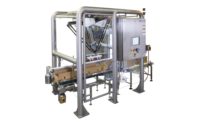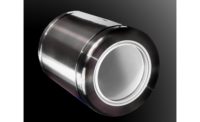Hygienic, Safe Reusable Poultry Crates & Containers
Sanitization and cleanliness for reusable crates and containers for meat and poultry transport is incredibly important. Infectious diseases like E. coli, BSE (bovine spongiform encephalitis) affect beef, Trichinosis is a disease found in pork, and Salmonella and campylobacter, for example, present a serious risk in poultry products.
When you consider that these types of products are often distributed nationwide or even globally, the need to minimize the risk of contamination is vital. Campylobacter, for example, is the most common cause of food poisoning in humans. Not only can the poultry products themselves become contaminated, but so can the reusable plastic packaging containers that hold them.
Cross-contamination can occur rapidly, spreading infection to unrelated flocks and causing a crisis of potentially massive product recalls and most importantly, potential widespread infection and sickness in consumers.
To help mitigate these risks, companies utilize innovative technologies to help reduce the risk of contamination as much as possible. One of the ways that companies are helping to accomplish this is through a silver coating technology on the crates and containers themselves.
BioCote Silver Ion Technology
Research from UK-based company BioCote shows that silver antimicrobial protection can help reduce the risk of cross-contamination. A barely visible silver coating is integrated into the reusable crates at the manufacturing stage.
Once it's incorporated, this silver coating effectively impedes the growth of bacteria such as campylobacter and effectively reduces the likelihood of the container becoming a source of cross-contamination and spreading dangerous infections to users and consumers.
In-depth testing that has been performed by BioCote shows that more than 14 times higher average counts of total bacteria were found on standard crates compared to BioCote treated crates.1
BioCote's silver ion technology is essentially a safe, natural antimicrobial agent that inhibits the growth of a wide range of bacteria on product surfaces.
Incidentally, this same technology is also currently being integrated into a labeling technology specifically engineered for difficult to label plastics, such as what many meat and poultry crates are manufactured from.
This technology is called Polymer Fusion Labeling, and it can play a vital role in the reusable meat and poultry packaging industry.
The same way that a crate can become contaminated, so too can traditional labeling methods become vulnerable to bacteria, such as in adhesive-based labels.
Polymer Fusion Labeling presents a two-fold solution that is in line with hygienic crate efforts:
1). True label permanency is achieved through patented “fusion” technology, and
2). Safe, hygienic, antimicrobial enhancement is reinforced through BioCote silver ion technology.
Why Do Typical Labels Fail On Reusable Plastics?
The vast majority of meat and poultry crates and containers are made of high-density polyethylene plastic (HDPE). This plastic is chosen specifically for its superior performance including puncture resistance, chemical resistance during sanitization procedures, and long service life as a reusable.
However, the performance properties that make HDPE such a versatile material for reusable crates and containers also make it problematic for common “adhesion-based” warning labeling methods available today (e.g., pressure-sensitive adhesive, in-mold, hot stamp foil, heat transfer, silkscreen, pad printing, and more) that are intended to be on the product for life use.
“Real World” results prove that common labeling methods are continuously failing their informative, branding, and hygienic duty on HDPE crates and containers. This comes as no surprise as containers and labeling are consistently being subjected to extremely harsh environments (sanitation cycles, extreme temperatures, chemicals, moisture and more) numerous times throughout their lifespan that renders “adhesion-based” methods inoperative.
Apart from crucial information going missing or being unreadable, damaged labels pose an additional threat. Exposed layers and sticky adhesives are proven sites where bloodborne pathogens and other microbes harbor safely away from exposure to disinfectants and sanitation cycles.
Not only are typical labeling methods vulnerable to failure, but just like the potential for the meat and poultry crates to become a source of cross-contamination, the labels are also unfortunately susceptible to becoming a breeding ground for bacteria to thrive and spread infection.
Polymer Fusion Labeling: A Permanent, Hygienic and Safe Solution
Polymer Fusion Labeling Technology is the science of merging two separate polyolefin thermoplastic polymers together (polyolefin label + polyolefin product) utilizing melting point, time, and pressure, which produces a singular piece of plastic without the use of adhesives, tie layers, bonding agents, or secondary surface treatments.
This labeling technology was specifically engineered for perfect compatibility with the type of plastics that meat and poultry crates are manufactured from to deliver unrivaled lifelong performance.
The labels are also able to be manufactured to FDA safety standards and regulations.
BioCote (silver ion) antimicrobial additives are then introduced into the polymer matrix of our Fusion Technology inks during production and printed as part of a logo, warning label, or informative graphic that is then applied onto customers' reusable poultry and meat containers. It's the same technology that some companies are already using as the silver coating on the crates themselves.
According to BioCote, “the technology has been proven to be efficacious against a wide range of microbes – bacteria, mold, and viruses while being resistant to exposure to commonly used cleaning disinfectants for the life of the product.”
During application, the Polymer Fusion Label with BioCote and the plastic crate or container simultaneously reach the proper melting point, which causes a “fusion reaction.”
The result: a permanent warning, safety, branding, or informative label on plastic that cannot be lifted, separated, or removed for the life of the product no matter the environment or exposure.
It also means no more exposed layers or sticky adhesives where microbes hide, leaving users and consumers susceptible to contact and inhibiting the spread of unwanted diseases or infections.
Polyfuze’s industry-leading Lifetime Guarantee means peace of mind knowing Polymer Fusion Technology has your back for the life of your meat and poultry crates and containers.
If you’re interested in finding out more about Polymer Fusion Labeling permanent and hygienic solutions for reusable crates and containers, please call 928-634-8888 or visit www.polyfuze.com.
1.(Source) https://www.poultryworld.net/Home/General/2010/7/Chicken-crates-with-a-silver-touch-WP007684W/









